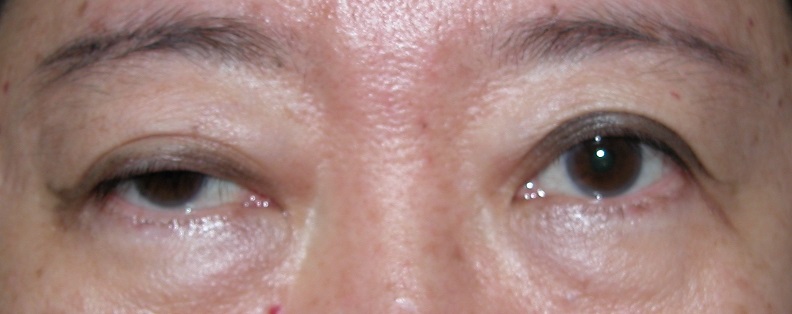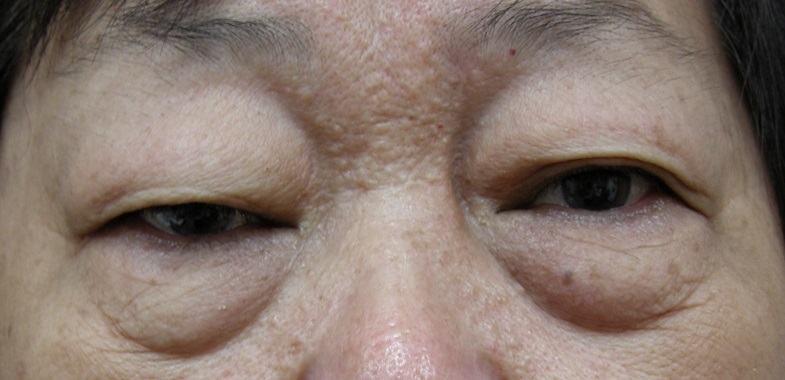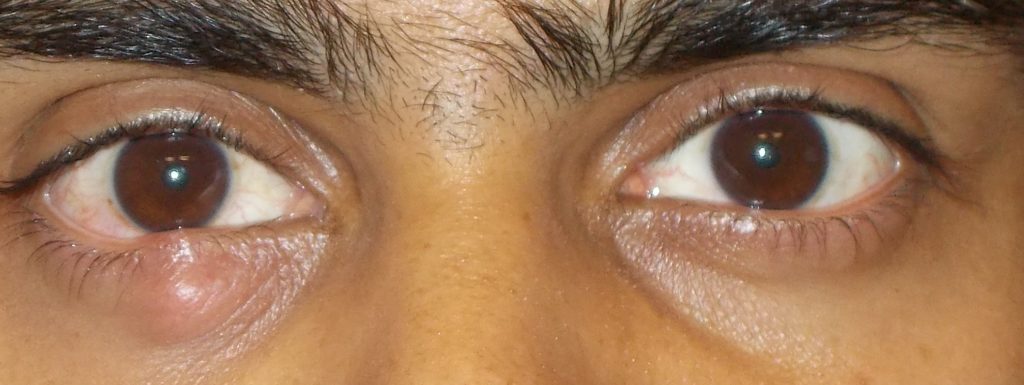Below are some common eyelid conditions.
- Droppy Eyelids – Ptosis
- The Double Eyelid Procedure – Upper Eyelid Blepharoplasty
- Eyebags 眼袋
- Inturned and Out-turned Eyelids
- Puffy Eyelids / Redundant Eyelid Skin (Upper or Lower) – Dermatochalasis
- Lumps and Bumps of the Eyelids – Infection of the Eyelids
Droopy Eyelids – Ptosis
Droopy lids can make one look sleepy, inattentive, or even angry and grumpy. It can in more severe cases, block our line of sight. Secondarily, as a result of a subconscious effort to elevate the lids, patients present with excessive forehead frown lines, and may even complain of fatigue as a result of continued attempts to raise their upper eyelids to compensate for the droopy lids blocking their line of sight.
Ptosis of the eyelids, otherwise known as droopy eyelids, is commonly due to a weakness of the muscle that raises the upper eyelid. There are other causes (such as nerve disease) but the majority of the conditions are age related.
Patients with ptosis complain of the droopy lid or lids making them look sleepy or angry, blocking their vision, or causing them headaches or tiredness as they try to compensate for the condition by using their brows to lift up the eyelids.
Broadly, the condition can be congenital or acquired. The most accepted classification is based on the structure affected viz. neurogenic (the nerve to the muscle), myogenic (the levator muscle itself is is malformed at bith in congenital ptosis), aponeurotic (the sheet connecting the muscle to the eyelid plate, which becomes stretched or disinserted with age, the most common type), and others.
Treatment is targeted at the cause, and frequently involves surgery (exception being myasthenia gravis, a neurological condition which can be treated with medication, and which is diagnosed with a thorough consultation), and is usually highly successful.
Ptosis surgery restores both function and appearance to the patient and as such, in the Singapore context, patients can use Medisave for the procedure because it is medically necessary. In patients who are insured, the majority (exception being congenital ptosis) will be reimbursed through their coverage plans.
Ptosis surgery is performed under regional anaesthesia so that adjustment and titration is possible. Downtime is one to two weeks, and the wound corresponds to where the double eyelid crease is. Stitches are removed after one week, and the patients will be applying medication to the wound for one to two weeks after the procedure.

The Double Eyelid Procedure – Upper Eyelid Blepharoplasty
Cosmetic creation of double eyelids is among the most sought after of all cosmetic procedures. This is due to the low or absent upper eyelid crease in patients of Oriental descent.
Medically, the crease is formed by the forward extension of the tendon of the muscle that elevates the upper eyelid – the levator aponeurosis, and Orientals have this insertion very close to the eyelid margin.
The procedure is termed Upper Eyelid Blepharoplasty and there are 2 methods viz the Transcutaneous method and the scarless or Internal Blepharoplasty methods.
Each has its pros and cons. The transcutaneous methods afford an opportunity for the surgeons to remove excess skin and a chance to remove excess fat, which contribute to the puffy appearance. The scar however needs to be managed appropriately, and the procedure is more expensive than the internal/ scarless method. The transcutaneous method has the added advantage of permanence.
The Internal Blepharoplasty method, otherwise known as the Suture Method, is a much quicker and less elaborate procedure that the transcutaneous method. However, complications can occur in under trained hands such as the suture rubbing against the eye (cornea) with disastrous consequences. The author has managed 3 such cases over the past year, all involving patients who have travelled overseas for medical tourism packages that offer the procedure at a fraction of the price in Singapore. The creases also often fade after 2-3 years.
Eyebags 眼袋
Eyebags below the eyes – this condition is among the most common reasons patients in their 30s to late ages seek cosmetic surgery. It is not just vanity that drives patients to seek treatment for eyebags below the eyes, but often, the condition causes them to look tired or haggard beyond their years.
Eyebags can be due to a variety of reasons and not just attributable to fat excess alone. In many cases, it is due to a deflation (loss of volume) of the midface that accentuates the puffiness of the region above it. In other instances, the skin below the eyes age and become crepe like (as the accompanying photo illustrate). Sometimes, it is due to a loss of tone of the lower lid tendon, and when untrained surgeons fail to recognize the true reasons behind the problem, and proceed to simply remove fat from under the eye, the patients not only look gaunt and have the region sunken in, they also have resultant complications such as an out-turning of the lower lids (ectropion), or worse, an inability to close their eyes.
Treatment for the condition is termed Lower Eyelid Blepharoplasty. There are 2 methods viz. Transconjunctival lower blepharoplasty, which does not involve a cut on the outside of the eyelid skin (thus scarless) and Transcutaneous lower blepharoplasty, which gives an opportunity for redundant and lax skin to be removed. Many patients are under the mistaken impression that the scar in the latter method would look unsightly, but if the surgery is performed by adequately trained surgeons with meticulous attention to wound healing, the scarring is almost imperceptible.
Inturned and Out-turned Eyelids
Malposition of the eyelids – Entropion and Ectropion
Inturned Eyelids – Entropion
Entropion is a condition where the eyelid margin turns inwards to cause the lashes, and the margin, to rub against the eyes. It can occur both in the lower eyelids, or less commonly affect the upper eyelids.
The condition is caused mainly by involutional/ aging changes affecting the eyelid tissues, or as a result of scarring/ cicatricial changes affecting the back portion of the eyelids. Congenital entropion is a less common subtype caused by an excess of skin or the muscle around the eyelids, the orbicularis oculi.
Patients present with tearing, ocular irritation and redness or even with frequent discharge from the eyes.
Treatment consists of measures to address the root causes of the problem, eg tightening of the lower lid tendons or repair of the muscle that has been weakened due to age (the inferior retractor).
Downtime is about a week, whereupon the sutures are removed and the patients can go back to bathing the region around the eyes.
Out-turned Eyelids – Ectropion
Ectropion is rarer compared to entropion. It is also caused frequently by loosening of the tendon of the lower eyelids, akin to a tennis net that is loose.
Patients present with irritation and discomfort, due to the exposure of the tarsal conjunctiva, and often look dramatically different (as the accompanying patient photos illustrate).
Treatment is directed again at the root causes of the condition with a similar downtime as entropion surgery.
Puffy Eyelids / Redundant Eyelid Skin (Upper or Lower) – Dermatochalasis
Gravity, aging, loss of elastic tissue and sun exposure, amongst other factors, contribute to redundant and lax eyelid skin, a condition medically (but less commonly) known as dermatochalasis. It commonly affects the elderly, more often involving the upper eyelids, but can occur in young adults, and involve the lower eyelids as well.
Patients complain that their superior visual field is blocked by excessive upper eyelid skin, in which case the condition becomes a functional problem. When the condition is this advanced, patients would find that the excessive eyelid skin often gives them a puffy look and also complain that their eyelids are full or heavy. When patients complain of fullness and puffy eyelids, but without the condition blocking their vision, then the problem is only a cosmetic one. This distinction is important as when treatment is carried out for functional reasons, it is deemed medically necessary, and insured patients will be reimbursed according to the terms of their coverage, and in the Singaporean context, Medisave can be use for the treatment. Most patients do not realize that the condition can be a functional problem, often associating its treatment with other cosmetic treatments (which are not covered by insurance, and Medisave cannot be invoked), thereby delaying timely help and suffer in silence.
The condition is also frequently associated with an excess of fat in the region (the pre-aponeurotic fat pads in the upper lids and the fat pads in the lower eyelids) that accentuate the appearance of puffiness, and the treating surgeon has to address this issue appropriately.
Treatment is often surgical. Patients who tape their eyelids up may find temporary relief but it can never be a permanent solution. The surgical procedure is blepharoplasty, with or without removal or rearrangement of the fat pads. Patients often think that the treatment is cosmetic because blepharoplasty is also the medical term used to describe cosmetic creation of double eyelids (more of that later in this article).
Dermatochalasis can often co-exist with ptosis, where there is a weakness of the muscle responsible for elevating the upper eyelids. When surgeons treat dermatochalasis with blepharoplasty alone when there is co-existent ptosis, the result is often asymmetry and unhappiness all round.

Lumps and Bumps of the Eyelids – Infection of the Eyelids
Stye, Chalazion
These are conditions which are very common and when not properly managed, become a nuisance either because they are painful, or because they are unsightly on the eyelids.
A stye is an infection of the oil gland of the eyelid involving either the meibomian gland (the oil gland situated on the inner aspect of the eyelid margin) or the Gland of Zeis, the oil gland found at the base of an eyelash, and are therefore in a more outlying/superficial location on the eyelid.
A chalazion is a blockage of the oil gland and is strictly speaking, not painful. It may however become secondarily infected.
Much confusion exist as regards these terms, even amongst doctors, but all agree that if properly managed, one can avoid a nasty looking or painful problem.
Tips on the condition
Good eyelid hygiene will reduce the incidence of these occurrences. Sometimes, a small lesion will spontaneously resolve itself because the secretions/pus has found its way out of the natural gland opening. This forms the basis of conventional advice to apply intermittent compression of these lesions.
However, one must be careful to not compress for too long or too hard, in order that blood circulation to the eye do not get compromised.
Occasionally, in spite of one’s best efforts, these crop up, and it is wise to seek immediate consultation with an Eye specialist or Ophthalmologist.
At our practices, we have a special interest in the management of eyelid issues. I have found that if detected early enough, I am able to express the meibomian secretions or pus on the slit lamp (a piece of equipment that is present in an Eye Clinic), without resorting to painful incision and drainage procedures.

